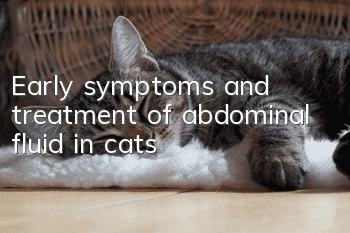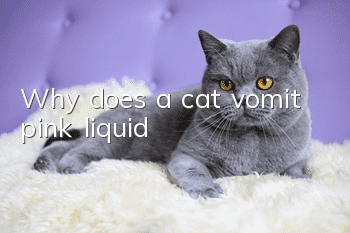Early symptoms and treatment of abdominal fluid in cats

Water accumulation in a kitten’s abdomen is a disease. When you find that a kitten has water accumulation in its abdomen, you must treat the kitten in time. Next, I will introduce to you some symptoms and solutions of water accumulation in a kitten’s abdomen.
1. In the early stage of ascites, there will be obvious abdominal distension, increased waist circumference, weight gain, and edema of the lower limbs
2. The abdomen is bulging and the abdominal wall is tight and shiny, like a frog belly. The patient has difficulty walking. Sometimes the diaphragm is significantly elevated, and shortness of breath and umbilical hernia occur
3. Pleural effusion, mostly seen on the right side, is caused by hepatic ascites entering the chest cavity through the diaphragmatic lymphatic vessels or transvalvular openings.
4. Hepatic ascites is accompanied by pleural effusion, which is more common on the right side. It is caused by hepatic ascites entering the chest cavity through the diaphragmatic lymphatic vessels or transvalvular openings. Early symptoms of hepatic ascites, accompanied by liver failure
Symptomatic treatment methods:
1. Diuretics: include thiazides, diuretic acid, furosemide, etc. However, furosemide may induce liver damage, so some people oppose its use. These drugs can block Na+ reabsorption in the proximal renal tubule, thereby increasing the Na+ concentration in the distal renal tubule, stimulating Na-K exchange, and increasing K+ excretion. When taking the above diuretics for a long time, care must be taken to prevent hypoxia. Kemia. Therefore, in clinical practice, the above-mentioned drugs are often combined with diuretics with K-sparing ability such as spironolactone or triamterene. The former competitively inhibits the effect of aldosterone on the distal renal tubule, and the latter inhibits the reabsorption of Na+. As a result, both can excrete Na+ and preserve K+. If furosemide is used, start with 1 to 2 mg/kg/time, 1 to 2 times a day, intravenously or intramuscularly, for 4 to 7 consecutive days. If the effect is not obvious, it can be changed to 2 to 3 mg/kg/time, each time. Administer 2 to 3 times a day. Thiazides should be taken at a dose of 2 to 4 mg/kg once every 12 hours, and the combined dose of amtisolactone should be taken at a dose of 1 to 2 mg/kg, twice a day. If it is ineffective, the dose can be doubled.
2. Low-salt diet.
3. When breathing is difficult or appetite is significantly reduced, ascites should not be drained unless absolutely necessary. Because if ascites is drained, a large amount of protein contained in the ascites will be lost, which may also cause peritonitis, decreased blood volume, etc. There is a so-called Laveen short-circuit surgical therapy, which involves implanting a special pump-like device into the abdominal cavity. The led catheter is connected to the jugular vein through the subcutaneous tissue, and the ascites is returned to the vein under the pump-like action of the diaphragm. When ascites is drained, a substitute plasma must be injected intravenously, or whole blood or plasma can be transfused.
4. For inflammatory ascites, select sensitive antibiotics for antibacterial treatment based on the results of the drug sensitivity test.
- What should I do if my newborn kitten won’t suck milk?
- What should I do if my cat loves to bite? How to correct your cat’s biting habit
- What are the common diseases of cats with folded ears? It is important to understand and prevent them in time!
- Why does a two-month-old kitten keep biting people?
- How to train a cat to eat obediently? Teach you how to train a cat scientifically!
- Do cats in estrus urinate randomly?
- Which one has higher IQ, cats or dogs?
- It turns out to be the killer of cat tapeworms. How to prevent it?
- Why do chinchilla cats need to be neutered?
- What should British shorthair cats eat?



